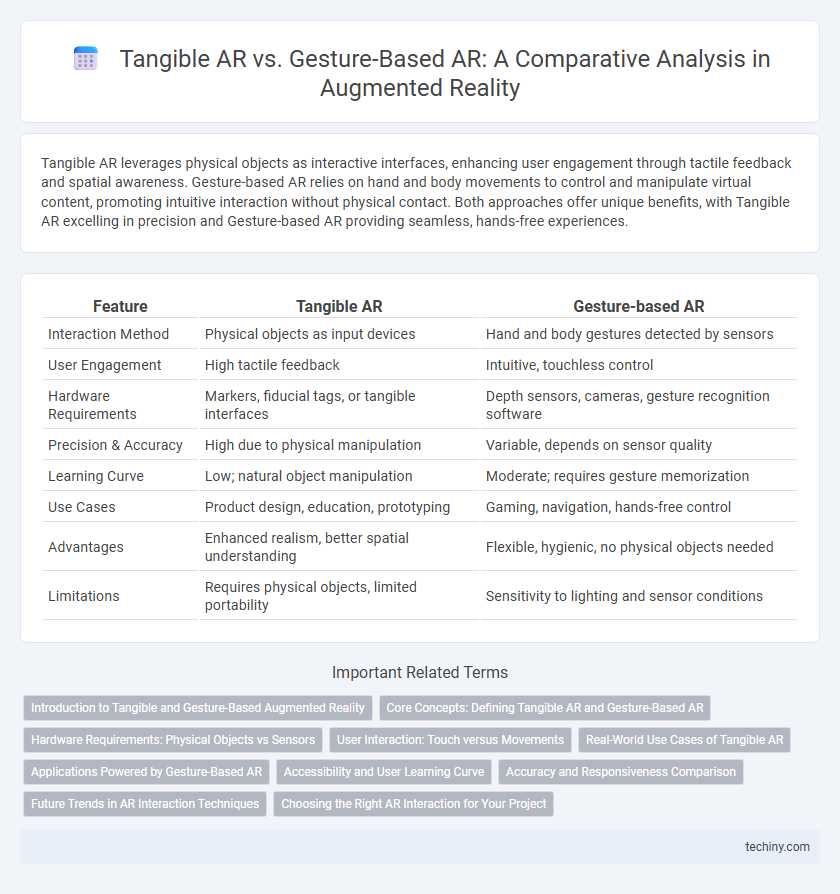Tangible AR leverages physical objects as interactive interfaces, enhancing user engagement through tactile feedback and spatial awareness. Gesture-based AR relies on hand and body movements to control and manipulate virtual content, promoting intuitive interaction without physical contact. Both approaches offer unique benefits, with Tangible AR excelling in precision and Gesture-based AR providing seamless, hands-free experiences.
Table of Comparison
| Feature | Tangible AR | Gesture-based AR |
|---|---|---|
| Interaction Method | Physical objects as input devices | Hand and body gestures detected by sensors |
| User Engagement | High tactile feedback | Intuitive, touchless control |
| Hardware Requirements | Markers, fiducial tags, or tangible interfaces | Depth sensors, cameras, gesture recognition software |
| Precision & Accuracy | High due to physical manipulation | Variable, depends on sensor quality |
| Learning Curve | Low; natural object manipulation | Moderate; requires gesture memorization |
| Use Cases | Product design, education, prototyping | Gaming, navigation, hands-free control |
| Advantages | Enhanced realism, better spatial understanding | Flexible, hygienic, no physical objects needed |
| Limitations | Requires physical objects, limited portability | Sensitivity to lighting and sensor conditions |
Introduction to Tangible and Gesture-Based Augmented Reality
Tangible Augmented Reality integrates physical objects with digital content, allowing users to manipulate virtual elements through real-world interactions, enhancing spatial awareness and immersion. Gesture-based Augmented Reality relies on hand and body movements detected by sensors or cameras, enabling intuitive control of virtual environments without physical interfaces. These two AR modalities offer distinct user experiences, with tangible AR emphasizing tactile engagement and gesture-based AR focusing on natural, motion-driven interactions.
Core Concepts: Defining Tangible AR and Gesture-Based AR
Tangible Augmented Reality (AR) integrates physical objects as interactive controllers within digital environments, enabling users to manipulate virtual content through tangible interfaces. Gesture-Based AR relies on recognizing user hand movements and gestures to interact with augmented elements, employing sensors and cameras for real-time tracking. Both approaches prioritize natural user interaction but differ in input modality--Tangible AR emphasizes physical object manipulation, while Gesture-Based AR centers on dynamic human gestures.
Hardware Requirements: Physical Objects vs Sensors
Tangible AR relies on physical objects such as markers, props, or surfaces to anchor digital content, requiring hardware like cameras and specialized trackers to detect and interact with these items. Gesture-based AR depends on advanced sensors and cameras, including depth sensors and motion detectors, to interpret user hand and body movements without the need for physical objects. The hardware demands for tangible AR emphasize object recognition and tracking, whereas gesture-based AR prioritizes high-precision sensor arrays for real-time gesture detection and spatial awareness.
User Interaction: Touch versus Movements
Tangible AR enhances user interaction through direct touch, allowing users to manipulate physical objects that are digitally augmented for a more immersive and intuitive experience. Gesture-based AR relies on users' hand and body movements to interact with virtual elements, offering a contactless and natural control method. Both interaction modes optimize user engagement by leveraging different sensory inputs: tactile feedback in Tangible AR and motion recognition in Gesture-based AR.
Real-World Use Cases of Tangible AR
Tangible AR integrates physical objects as interactive interfaces, enhancing user engagement in real-world applications such as medical training, industrial maintenance, and educational simulations. This approach enables precise manipulation and tactile feedback, improving task accuracy and learning outcomes. Industries leverage Tangible AR to streamline workflows, reduce errors, and elevate hands-on experiences compared to gesture-based AR systems.
Applications Powered by Gesture-Based AR
Gesture-based AR enables immersive user interactions in fields like gaming, enhancing real-time control without physical devices. In healthcare, surgeons utilize gesture recognition for precise, hands-free navigation during operations. Industrial applications leverage gesture-based AR for remote equipment control, improving safety and operational efficiency.
Accessibility and User Learning Curve
Tangible Augmented Reality leverages physical objects to interact with digital content, offering intuitive and accessible experiences that minimize the user learning curve by relying on familiar, hands-on manipulation. Gesture-based AR requires users to master specific hand or body movements, which can present a steeper learning curve and potential accessibility barriers for individuals with limited motor skills. Accessibility in Tangible AR is often enhanced due to tactile feedback, whereas Gesture-based AR depends heavily on accurate motion detection and user capability.
Accuracy and Responsiveness Comparison
Tangible AR systems leverage physical objects as interactive interfaces, offering superior accuracy due to direct manipulation and precise spatial tracking, which enhances user control and reduces latency. Gesture-based AR relies on interpreting hand movements through cameras or sensors, often encountering challenges with recognition errors and slower response times in complex or dynamic environments. Overall, tangible AR provides more reliable responsiveness and consistent accuracy, making it preferable for tasks requiring precise input.
Future Trends in AR Interaction Techniques
Tangible AR leverages physical objects to manipulate digital content, enhancing user engagement with intuitive, hands-on interaction, while Gesture-based AR relies on motion sensors and cameras to interpret hand and body movements for seamless control. Future trends indicate a convergence of these techniques, integrating haptic feedback and AI-driven gesture recognition to create more immersive, adaptive user experiences. Advances in wearables, machine learning algorithms, and spatial computing will drive the evolution of AR interaction techniques, enabling more natural and precise user inputs across diverse applications.
Choosing the Right AR Interaction for Your Project
Tangible AR leverages physical objects to create intuitive and engaging user interactions, making it ideal for projects requiring precise manipulation and strong sensory feedback. Gesture-based AR relies on hand movements and spatial recognition, offering a hands-free experience well-suited for applications emphasizing mobility and natural user interface. Selecting the appropriate AR interaction depends on the project's goals, user environment, and the level of interactivity needed to enhance user engagement and effectiveness.
Tangible AR vs Gesture-based AR Infographic

 techiny.com
techiny.com